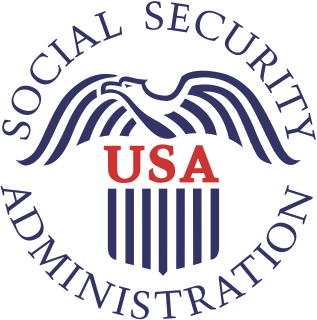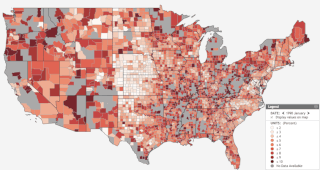Related Research Articles
Supplemental Security Income (SSI) is a means-tested program that provides cash payments to disabled children, disabled adults, and individuals aged 65 or older who are citizens or nationals of the United States. SSI was created by the Social Security Amendments of 1972 and is incorporated in Title 16 of the Social Security Act. The program began operations in 1974.

The United States Social Security Administration (SSA) is an independent agency of the U.S. federal government that administers Social Security, a social insurance program consisting of retirement, disability and survivor benefits. To qualify for most of these benefits, most workers pay Social Security taxes on their earnings; the claimant's benefits are based on the wage earner's contributions. Otherwise benefits such as Supplemental Security Income (SSI) are given based on need.

Welfare is a type of government support intended to ensure that members of a society can meet basic human needs such as food and shelter. Social security may either be synonymous with welfare, or refer specifically to social insurance programs which provide support only to those who have previously contributed, as opposed to social assistance programs which provide support on the basis of need alone. The International Labour Organization defines social security as covering support for those in old age, support for the maintenance of children, medical treatment, parental and sick leave, unemployment and disability benefits, and support for sufferers of occupational injury.
Social Security Disability Insurance is a payroll tax-funded federal insurance program of the United States government. It is managed by the Social Security Administration and designed to provide monthly benefits to people who have a medically-determinable disability that restricts their ability to be employed. SSDI does not provide partial or temporary benefits but rather pays only full benefits and only pays benefits in cases in which the disability is "expected to last at least one year or result in death." Relative to disability programs in other countries in the Organisation for Economic Co-operation and Development (OECD), the SSDI program in the United States has strict requirements regarding eligibility.
The California Medical Assistance Program is California's Medicaid program serving low-income individuals, including families, seniors, persons with disabilities, children in foster care, pregnant women, and childless adults with incomes below 138% of federal poverty level. Benefits include ambulatory patient services, emergency services, hospitalization, maternity and newborn care, mental health and substance use disorder treatment, dental (Denti-Cal), vision, and long term care and supports. Approximately 13.3 million people were enrolled in Medi-Cal as of January 2018, or about one-third of California's population; in Tulare County and Merced County, more than 50% of county residents were enrolled as of September 2015.
The California Department of Social Services (CDSS) is a California state agency for many of the programs defined as part of the social safety net in the United States, and is within the auspices of the California Health and Human Services Agency. Federal and State funds for adoptions, the largest SNAP program in the country, CalWORKs program, foster care, aid for people with disabilities, family crisis counseling, subsistence payments to poor families with children, child welfare services and many other efforts are distributed through this department.
Social security, in Australia, refers to a system of social welfare payments provided by Australian Government to eligible Australian citizens, permanent residents, and limited international visitors. These payments are almost always administered by Centrelink, a program of Services Australia. In Australia, most payments are means tested.

Social programs in the United States are programs designed to ensure that the basic needs of the American population are met. Federal and state social programs include cash assistance, health insurance, food assistance, housing subsidies, energy and utilities subsidies, and education and childcare assistance. Similar benefits are sometimes provided by the private sector either through policy mandates or on a voluntary basis. Employer-sponsored health insurance is an example of this.
The Center for Development of Human Services (CDHS) was a sponsored nonprofit program of the Research Foundation of the State University of New York located at Buffalo State College. CDHS/ Research Foundation began in 1976 when a small group of Buffalo State College faculty was successful in obtaining a $100,000 social services training grant to provide instruction to those employed in the field of social work. The Social Services Training Project, as it was then called, evolved into CDHS/Research Foundation, now a nationally recognized provider of human services training. CDHS/Research Foundation used to manage over 30 human services training projects representing $50 million in grant-funded activities that serve the residents of New York State and was the largest such provider in the state. From 1999 to 2010, under the leadership of Robert Spaner, Project Director and Principal Investigator, CDHS expanded from a $16 million operation with under 100 staff to a $60 million Center with 400 staff and 40 separate projects. In April, 2010 Mr. Spaner retired. CDHS used to be headquartered in Buffalo, with satellite offices in Rochester, Syracuse, Albany, and New York City. A large number of CDHS staff worked with state and local government agencies statewide.
The New York State Office of Children and Family Services (OCFS) is an agency of the New York state government within the Department of Family Assistance. The office has its headquarters in the Capital View Office Park in Rensselaer.

The Oklahoma Department of Human Services (OKDHS) is an agency of the government of Oklahoma. Under the supervision of the Oklahoma Secretary of Health and Human Services, OKDHS is responsible for providing help to individuals and families in need through public assistance programs and managing services for seniors and people with disabilities.
The Pennsylvania Department of Human Services is a cabinet-level state agency in Pennsylvania. The Pennsylvania Department of Human Services’s seven program offices administer services that provide care and support to Pennsylvania's most vulnerable citizens. These services include eligibility and benefits determination, foster care, juvenile justice, early childhood development, services for persons with developmental disabilities, autism services, long term living programs, management of state psychiatric hospitals, and management of the Medical Assistance physical and behavioral health care programs. The Department consists of executive offices and seven program offices that include:
The Family Eviction Prevention Supplement was created by the New York City Human Resources Administration in May 2005 as a program to help prevent evictions of families on welfare shelter. It provides additional housing assistance to Cash Assistance (CA) eligible families with children, above and beyond the CA shelter amount.

The New York State Department of Family Assistance (DFA), also known as the Department of Family Services, is a department of the New York state government. Its regulations are compiled in title 18 of the New York Codes, Rules and Regulations.
The Human Resources Administration or Department of Social Services (HRA/DSS) is the department of the government of New York City in charge of the majority of the city's social services programs. HRA helps New Yorkers in need through a variety of services that promote employment and personal responsibility while providing temporary assistance and work supports. Its regulations are compiled in title 68 of the New York City Rules. The current Commissioner of HRA is Stephen Banks, who was appointed to the position in April, 2014 by Mayor Bill de Blasio. HRA is the largest city social services agency in the United States. It has a budget of $9.7 billion, employs over 14,000 people, and serves over 3 million New Yorkers.
Welfare in California consists of federal welfare programs—which are often at least partially administered by state and county agencies—and several independent programs, which are usually administered by the counties.

CalFresh is the California implementation of the federal Supplemental Nutrition Assistance Program (SNAP), formerly known as the Food Stamp program, which provides financial assistance for purchasing food to low-income California residents.

Unemployment insurance in the United States, colloquially referred to as unemployment benefits, refers to social insurance programs which replace a portion of wages for individuals during unemployment. The first unemployment insurance program in the U.S. was created in Wisconsin in 1932, and the federal Social Security Act of 1935 created programs nationwide that are administered by state governments. The constitutionality of the program was upheld by the Supreme Court in 1937.
This article is intended to give an overview of the welfare system in the U.S. State of New York.
The social protection system in Azerbaijan consists of programs aimed at reducing the poverty and economic problems of the population through promoting effective labor markets as well as reducing the risks faced by citizens. Social insurance consists of pensions, unemployment benefit, health insurance, and other social benefits.
References
- 1 2 "New York Consolidated Laws, Social Services Law - SOS § 21". Findlaw. Retrieved November 21, 2021.